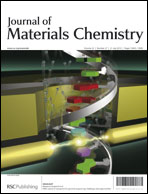Ce3+-doped Ba2Ln(BO3)2Cl (Ln = Gd, Y) phosphors were synthesized through a conventional high-temperature solid state method in CO atmosphere. Structural and spectroscopic characterizations of the samples have been performed by X-ray diffraction and photoluminescence spectra measurements. The phosphors can be efficiently excited by near ultraviolet (n-UV) light resulting in blue emission. The optimal Ce3+ dopant concentrations in both compounds were determined, and the concentration quenching mechanisms were also discussed. The photoluminescence excitation (PLE) and emission (PL) spectra, and decay curves at liquid helium temperature were measured to analyze the crystallographic occupancy sites of Ce3+ in the Ba2Ln(BO3)2Cl (Ln = Gd, Y) hosts. The thermal stabilities of the phosphors Ba2Ln(BO3)2Cl:Ce3+ (Ln = Gd, Y) were studied using the dependence of the luminescence intensities on temperature (300–500 K), and their luminescence quenching temperatures and thermal activation energies were also determined. The results indicate that the phosphor Ba2Gd(BO3)2Cl:Ce3+ offers excellent optical properties as a potential blue-emitting phosphor candidate for n-UV LEDs, such as a higher thermal stability and a stronger luminescence intensity, than those of the phosphor Ba2Y(BO3)2Cl:Ce3+.

You have access to this article
 Please wait while we load your content...
Something went wrong. Try again?
Please wait while we load your content...
Something went wrong. Try again?


 Please wait while we load your content...
Please wait while we load your content...